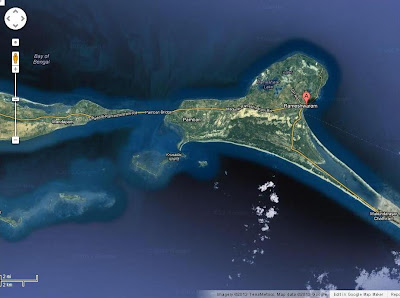On the pilgrimage from Rameswaram, from the Sri Ramanathaswamy Jyotirlinga Temple, northwards, is the Sri Mallikarjunaswamy Jyotirlinga Temple at Srisailam, Kurnool District, Andhra Pradesh. Set deep within the mountain ranges, above the steep cliffs over the Krishna River, within the Nagarjunasagar Project Tiger Reserve, you cannot but help wonder about the significance of the association of Shiva with water. In Rameswaram, is the association with 65 natural freshwater perennial springs, continuing to flow with freshwater only, since the Ramayana. This, in an island out in the sea. And, now, at Srisailam, high up in the hills, nestling the amazingly wonderful watershed of the Nagarjunasagar forests, is the second Jyotirlinga temple, as you move northwards.
Srisailam town and mandal, hidden deep within the Nallamalai hills of Kurnool District is in one of the most pristine forests of India. On the River Krishna, it is located high up in the steep vertical cliffs that overlook the river. Just about more than 200 kms south of Hyderabad, it is easily accessible with excellent road network.
The temple is usually referred to as the Srisailam Jyotirlinga Temple. Shiva is recognised in his manifestation here at Srisailam as Sri Mallikarjunaswamy, and Parvathi is recognised in her manifestation as Bhramaramba. Thus, the temple is known as the Sri Bhramaramba Mallikarjunaswamy Jyotirlinga Temple at Srisailam.
The temple is mentioned in the Skanda Purana with its own chapter titled Srisaila Kandam, and therefore indicates the antiquity of the Jyotirlinga manifestation. Several other leading saints have visited Srisaila over thousands of years. Adi Sankara has visited Srisaila and composed his veneration - Sivananda Lahiri at the temple. The temple finds mention in the puranas and the Mahabharata.
Important places at Srisailam for pilgrimage and tourism
Akka Mahadevi Caves - Named after the ascetic, lyricist and philosopher from Karnataka, it is said that Akka Mahadevi worshiped Shiva in his lingodbhava roopam in the deep caves.
Srisailam Nagarjunasagar Dam - On the Krishna River, is 512 m long.
Nagarjunasagar Srisailam Project Tiger Reserve and Wildlife Sanctuary - One of the largest tiger reserves in India, covering 3500 sq km.
Hemareddy Mallamma Temple - about 500 meters near the Sri Mallikarjunaswamy Temple, is the Hemareddy Mallamma ashram. A devotee of Shiva, it is believed that she could talk to him and seek solace for her problems.
Mallela Teertham - Beautiful waterfall in the forests, 50 kms before one reaches Srisailam.
View Larger Map
Sri Bhramaramba Mallikarjunaswamy Jyotirlinga Temple settlement areas
on the Srisailam Nallamalais Plateau within the Nagarjunasagar Project
Tiger Reserve and Reservoir area. Kurnool District, Andhra Pradesh
Srisailam town and mandal, hidden deep within the Nallamalai hills of Kurnool District is in one of the most pristine forests of India. On the River Krishna, it is located high up in the steep vertical cliffs that overlook the river. Just about more than 200 kms south of Hyderabad, it is easily accessible with excellent road network.
The temple is usually referred to as the Srisailam Jyotirlinga Temple. Shiva is recognised in his manifestation here at Srisailam as Sri Mallikarjunaswamy, and Parvathi is recognised in her manifestation as Bhramaramba. Thus, the temple is known as the Sri Bhramaramba Mallikarjunaswamy Jyotirlinga Temple at Srisailam.
The temple is mentioned in the Skanda Purana with its own chapter titled Srisaila Kandam, and therefore indicates the antiquity of the Jyotirlinga manifestation. Several other leading saints have visited Srisaila over thousands of years. Adi Sankara has visited Srisaila and composed his veneration - Sivananda Lahiri at the temple. The temple finds mention in the puranas and the Mahabharata.
Important places at Srisailam for pilgrimage and tourism
Akka Mahadevi Caves - Named after the ascetic, lyricist and philosopher from Karnataka, it is said that Akka Mahadevi worshiped Shiva in his lingodbhava roopam in the deep caves.
Srisailam Nagarjunasagar Dam - On the Krishna River, is 512 m long.
Nagarjunasagar Srisailam Project Tiger Reserve and Wildlife Sanctuary - One of the largest tiger reserves in India, covering 3500 sq km.
Hemareddy Mallamma Temple - about 500 meters near the Sri Mallikarjunaswamy Temple, is the Hemareddy Mallamma ashram. A devotee of Shiva, it is believed that she could talk to him and seek solace for her problems.
Mallela Teertham - Beautiful waterfall in the forests, 50 kms before one reaches Srisailam.
View Larger Map
Sri Bhramaramba Mallikarjunaswamy Jyotirlinga Temple settlement areas
on the Srisailam Nallamalais Plateau within the Nagarjunasagar Project
Tiger Reserve and Reservoir area. Kurnool District, Andhra Pradesh
The temple settlement on the Nallamalai hills
Close up view of the temple quadrangle
The temple precincts
Hemareddy Mallela temple and ashram premises
Chatrapati Shivaji Memorial near the Srisailam Temple










